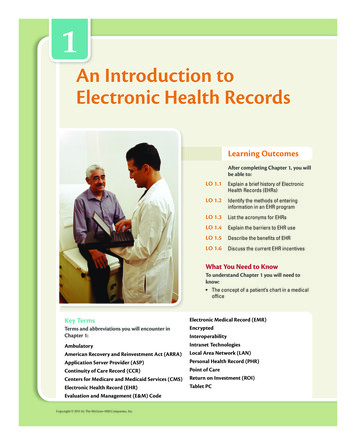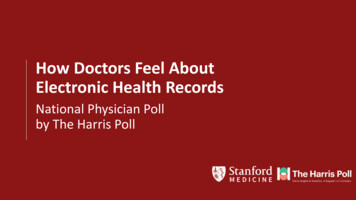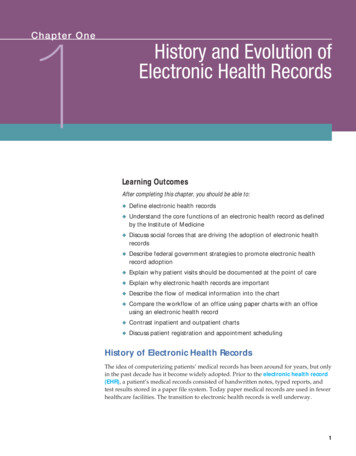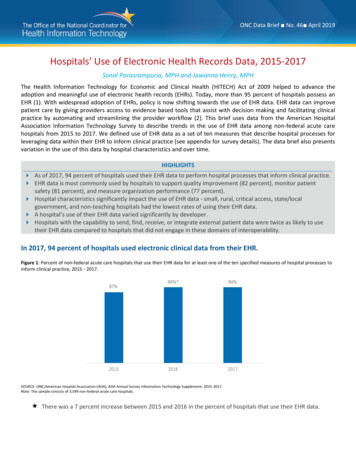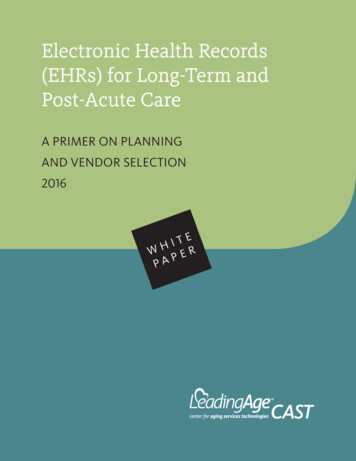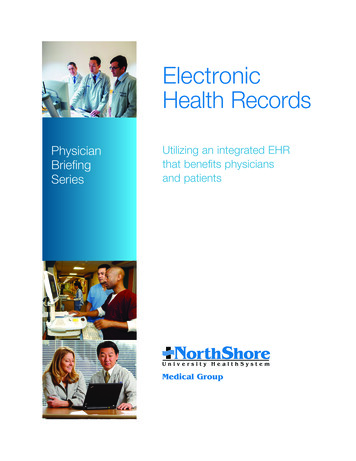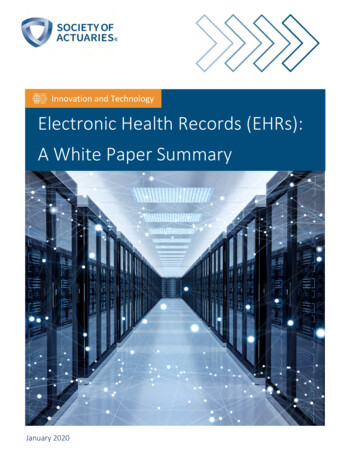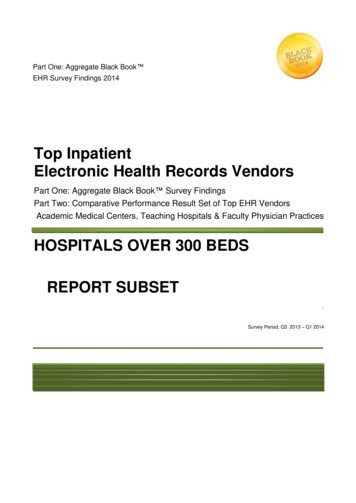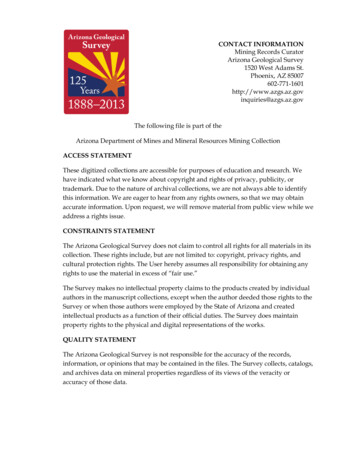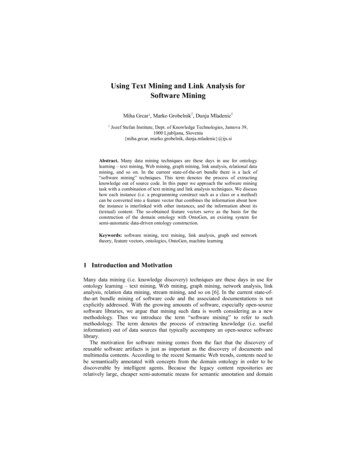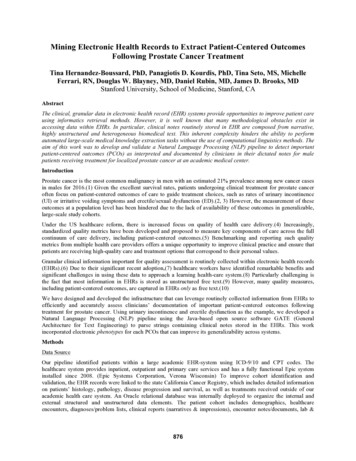
Transcription
Mining Electronic Health Records to Extract Patient-Centered OutcomesFollowing Prostate Cancer TreatmentTina Hernandez-Boussard, PhD, Panagiotis D. Kourdis, PhD, Tina Seto, MS, MichelleFerrari, RN, Douglas W. Blayney, MD, Daniel Rubin, MD, James D. Brooks, MDStanford University, School of Medicine, Stanford, CAAbstractThe clinical, granular data in electronic health record (EHR) systems provide opportunities to improve patient careusing informatics retrieval methods. However, it is well known that many methodological obstacles exist inaccessing data within EHRs. In particular, clinical notes routinely stored in EHR are composed from narrative,highly unstructured and heterogeneous biomedical text. This inherent complexity hinders the ability to performautomated large-scale medical knowledge extraction tasks without the use of computational linguistics methods. Theaim of this work was to develop and validate a Natural Language Processing (NLP) pipeline to detect importantpatient-centered outcomes (PCOs) as interpreted and documented by clinicians in their dictated notes for malepatients receiving treatment for localized prostate cancer at an academic medical center.IntroductionProstate cancer is the most common malignancy in men with an estimated 21% prevalence among new cancer casesin males for 2016.(1) Given the excellent survival rates, patients undergoing clinical treatment for prostate canceroften focus on patient-centered outcomes of care to guide treatment choices, such as rates of urinary incontinence(UI) or irritative voiding symptoms and erectile/sexual dysfunction (ED).(2, 3) However, the measurement of theseoutcomes at a population level has been hindered due to the lack of availability of these outcomes in generalizable,large-scale study cohorts.Under the US healthcare reform, there is increased focus on quality of health care delivery.(4) Increasingly,standardized quality metrics have been developed and proposed to measure key components of care across the fullcontinuum of care delivery, including patient-centered outcomes.(5) Benchmarking and reporting such qualitymetrics from multiple health care providers offers a unique opportunity to improve clinical practice and ensure thatpatients are receiving high-quality care and treatment options that correspond to their personal values.Granular clinical information important for quality assessment is routinely collected within electronic health records(EHRs).(6) Due to their significant recent adoption,(7) healthcare workers have identified remarkable benefits andsignificant challenges in using these data to approach a learning health-care system.(8) Particularly challenging isthe fact that most information in EHRs is stored as unstructured free text.(9) However, many quality measures,including patient-centered outcomes, are captured in EHRs only as free text.(10)We have designed and developed the infrastructure that can leverage routinely collected information from EHRs toefficiently and accurately assess clinicians’ documentation of important patient-centered outcomes followingtreatment for prostate cancer. Using urinary incontinence and erectile dysfunction as the example, we developed aNatural Language Processing (NLP) pipeline using the Java-based open source software GATE (GeneralArchitecture for Text Engineering) to parse strings containing clinical notes stored in the EHRs. This workincorporated electronic phenotypes for each PCOs that can improve its generalizability across systems.MethodsData SourceOur pipeline identified patients within a large academic EHR-system using ICD-9/10 and CPT codes. Thehealthcare system provides inpatient, outpatient and primary care services and has a fully functional Epic systeminstalled since 2008. (Epic Systems Corporation, Verona Wisconsin) To improve cohort identification andvalidation, the EHR records were linked to the state California Cancer Registry, which includes detailed informationon patients’ histology, pathology, disease progression and survival, as well as treatments received outside of ouracademic health care system. An Oracle relational database was internally deployed to organize the internal andexternal structured and unstructured data elements. The patient cohort includes demographics, healthcareencounters, diagnoses/problem lists, clinical reports (narratives & impressions), encounter notes/documents, lab &876
diagnostics results, medications (down to the ingredient level), treatment plans, procedures, billing summaries,patient history, patient surveys, and follow-up/ survival information. To develop vocabularies related to urinaryincontinence, irritative voiding symptoms and erectile dysfunction, a minimum of 100 charts selected at randomwere reviewed and terminology extracted. We performed manual chart review to estimate the positive and negativepredicted values of the workflow. We will randomly select 200 records. A urology research nurse manuallyvalidated these reports to create a gold standard.Patient-Centered Outcome PhenotypesPhenotypic algorithms were developed for identifying and extracting both cases and controls of UI and EDassessment from EHRs. Input categories include ICD-9/ICD-10 codes, billing codes, medications and vocabulariesmatched with existing ontologies from the National Center for Biomedical Ontology (NCBO) and Unified MedicalLanguage System (UMLS) concepts.(11) To improve accuracy, vocabularies where also manually curated with EHRterms found during manual chart review. The phenotypes of each of the three PCOs are available through thepublicly accessible repository PheKB (https://phekb.org) a knowledgebase for EHR-based phenotypes.(12)NLP Extraction of PCOsOur NLP pipeline analyzes the clinical narrative text of EHRs using GATE software.(13) GATE provides severalcustomizable processing resources that perform specific NLP processing tasks, i.e. tokenizers, sentence splitters,gazetteers which annotate documents based on look-up lists of keywords, parsers etc. Below, we describe thebuilding components of our GATE-based NLP application for extracting PCOs from clinical notes, which comprises(1) an ANNIE module to detect PCO mentions in narrative texts, (2) a ConText module to determine the semanticcontext of the PCO mentions, and (3) A JAPE module to annotate the PCO mentions in the text.We first used the English tokeniser from GATE's ANNIE plugin component that splits the text into simpleconstituent tokens such as numbers, punctuation and words of different types. Next, sentence splitting wasperformed using the RegEx sentence splitter, which is suitable when faced with irregular inputs, such as thoseregularly encountered in the contents of EHR clinical notes.Following tokenization and sentence splitting, a Hash Gazetteer (part of the ANNIE) was run on the clinical note tofind occurrences of PCO mentions. We developed three types of Gazetteer list files containing the various PCOrelated keywords in text that indicate PCO mentions. In addition to detecting the PCO mentions, our pipelinedetects the context of the PCO mention using the ConText algorithm.(14) The ConText algorithm determinedwhether the PCO mentioned in the clinical report was negated, hypothetical, historical, or experienced by someoneother than the patient. PCO mentions were Type I if the ConText algorithm did not negate the term but the textindicated a negated PCO. PCO mentions were Type II if the ConText algorithm did not negate the term, but the textindicated an “affirmed” PCO. Finally, PCO mentions were Type III if the ConText algorithm negated them and thetext indicated a negated PCO. (Table 1)PCOs were classified as follows: “Affirmed”, meaning the patient had the symptom; “Negated”, the patient did nothave the symptom; or “Discussed Risk”, the clinician documented the discussion regarding risks of PCOs bytreatment with the patient.Table 1. Example of sentences in the clinical note assigned to different types of Gazetter List files.TypeDescriptionExample sentencesAnnotation ValueConText NegatedINo urinary incontinenceHis urinary control is good.NegativeNoIIUrinary incontinenceHe reports urinary leakage.AffirmedNoIIINo urinary incontinenceNo urinary complaints.NegativeYesA gazetteer list file was also used to include keywords related to discussion of post-operative risk. When PCO termsappear with these terms in a sentence, the corresponding sentence is considered as a discussion of post-operative riskwith the patient, rather than a PCO per se. Additionally, a Gazetteer list is used to exclude terms that are used in analternative context (e.g. the term leakage related to urinary incontinence vs. leakage around the foley catheter).Finally, the regular expression pattern-matching engine called Java Annotation Patterns Engine (JAPE) was used to877
create annotations in the text of the clinical notes based the patterns in the text detected by the Gazetteer files andConText algorithm.EvaluationThe gold standard was used to evaluate our pipeline. The 200 records in the gold standard were processed andrecorded all mentions of PCOs and classified each according to the annotation value. These data were comparedwith the annotations in the gold standard and precision and recall metrics were calculated. The university’s InternalReview Board approved the studyResultsWe identified 7,109 male individuals who received treatment for prostate cancer from 2008 to 2016 from a single,large, academic medical center. Patients’ demographics are displayed in Table 2. Patients had a mean age at time ofdiagnosis of 65.1 (SD 8.9). The majority of patients had localized disease, with 65% Stage II and 83% with aGleason 7.Table 2. Patient Demographics for Prostate Cancer Patients in the EHR Database who received treatment between2008-2016VariableNAge. Mean (SD)Ethnicity, %WhiteHispanicBlackAsianOtherYear of Diagnosis, %20052006200720082009201020112012201320142015BMI, mean (SD)Stage, %Value7,10965.19 (0.11)01234UnknownGleason, 56.3018.87 (0.16)0.016.996.891.701.111.83878
UnknownCharlson Score, mean (SD)83.153.31 (0.03)Table 3 demonstrates the number of PCOs extracted from the different types of clinical notes, either history &physical or progress. The majority of PCO information extracted from the NLP pipeline came from the progressnotes for both urinary incontinence and erectile dysfunction as compared to the information found in the history &physical note set.Table 3. Number Of Notes with an Identified PCO, Stratified By Type Of Mention And Note LocationNote typeHistory & Physical (n 10093)Urinary IncontinenceErectile/Sexual HistoryDiscuss RiskProgress (n d-HistoryNegatedNegated -HistoryDiscuss Risk718311566734112235876359057702933410The patient-level assessments for the two PCOs in the EHR notes for urinary incontinence and erectile dysfunctionwithin our study cohort are displayed in Table 4. The results indicate that ED was assessed in 77.5% of the patientswhile UI in 59.4% prior to the primary treatment and 29% and 33% immediately following treatment.Table 4. Rates Of PCO Assessment Pre- And Post-Treatment, Stratified By Affirmed And Negated MentionsTime PeriodPCOAffirmedNegatedUI2891517AssessmentRate 21828.60-3 Months Post-TreatmentWe estimated that patients had a pre-treatment rate of UI to be 16%, with varying severity and pre-treatment rate of30% for ED (Figure 1). The rates for UI remained at approximately 40-50% 1-2 years after surgery and the rates forED were between 45-70% following treatment.879
Figure 1. Rates of Affirmed Urinary Incontinence and Erectile Dysfunction atDifferent Time points in the Treatment Pathway.Affirmed PCO10.80.60.4UI0.2ED0Baseline 3 Months 6 months 9 months12months18months24monthsTime Since TreatmentThe F-measure accuracy scores for the UI annotations against an unseen gold standard manually annotated by ourboard-certified Urology nurse was 87% affirmed, 96% negated, and 91% discuss risk. For the ED annotations the Fmeasure was 85%, 92%, and 90%, respectively. (Table 5)Table 5. Performance of NLP extraction application for PCOs using GATE Developer's corpus quality assurancevisual resourcePatient-Centered OutcomeAffirmedNegatedDiscuss 590.9029Urinary IncontinenceErectile/Sexual DysfunctionDiscussionUnder healthcare reform, stakeholders emphasize the importance of quality and patient-centered healthcare.Accordingly, government officials seek quality metrics that include meaningful outcomes, including those that gobeyond mortality and recurrence. However, efforts to establish guidelines for prostate cancer treatment have beendifficult to formulate due to insufficient evidence regarding relative benefits and risks of the different treatmentoptions, particularly important patient-centered outcomes such as urinary and erectile dysfunction.(2, 15) Here wefound clinicians regularly recorded this information in the unstructured text of EHRs. The current work expands onexisting models by focusing on ontology-based dictionaries to annotate free text associated with patient-centeredoutcomes. We have demonstrated our ability to efficiently and accurately use our methods on EHRs for qualityassessment of patient-centered outcomes.The rates of urinary incontinence and erectile dysfunction identified through our pipeline were highly concordantwith rates from surveys that are reported in the literature.(16-18) This highlights the ability of NLP algorithms toleverage routinely collected information from EHRs and efficiently and accurately assess clinicians’ documentation880
of patient-centered outcomes. Our study suggests that patient-centered outcomes, particularly for prostate cancerpatients, are important and monitored not only for the patient but also for the clinician. Given the lack of populationbased information on these important outcomes, NLP tools can clearly advance research and evidence in this area.Our NLP pipeline shows promising results for the task of advancing patient-centered outcomes research (PCOR). Todate, most quality metric analyses have used administrative datasets.(16-18) While these datasets are easy to use andreadily available, they are generated for billing purposes and lack important clinical details.(19-23) Paper recordsmay have more detail, but cannot be algorithmically assessed.(24-26) Prospective studies are not readily availableand often contain ascertainment bias.(27) These issues have limited the efficiency and effectiveness of efforts forquality improvement, organizational learning, and comparative effectiveness research, particularly in the area ofPCOR. Using our NLP pipeline, we can obtain population rates on PCOs efficiently and with high certainty. Suchwork can significantly advance the field and depth of PCOR.There are limitations to our study. First, our algorithms have been developed and tested in a single academic center.However, the clinical terms used in our algorithms are disseminated with a national repository (pheKB.org) andmultiple clinicians across different healthcare settings have vetted the clinical terms. We will be testing ouralgorithms in another healthcare system to ensure their generalizability. A second limitation is that our system onlyreports what the clinician documents and does not capture patient-reported outcomes. Many studies have highlightedthat clinicians’ documentation can be sparse and incomplete. However, our previous work indicated that thesepatient-centered outcomes are more prevalent in the clinical text than elsewhere in the EHRs. Finally, our algorithmshave been developed using American English and vocabularies and language rules would need to be developed forusage where another language is used in the EHR.A significant benefit of our NLP pipeline is that it leverages multiple sources of data to identify patients andoutcomes, including registry data, quality of life surveys, and other information from clinical trials within ourinstitute. Our dataset is updated regularly and it will likely continue to perform well, including the assessment ofthese outcomes immediately after the introduction of new treatments and technologies.ConclusionsWe developed an NLP pipeline for detecting clinical mentions of patient-centered outcomes in prostate cancerpatients. The current performance of the system appears sufficient to be used for population-based healthmanagement and to enhance evidence needed to help patients identify treatment pathways that reflect theirhealthcare values. Given the importance of these events under the healthcare reform, wide deployment of fullycomputerized algorithms that can reliably capture PCOs will have numerous applications for the healthcare industry.These approaches are the basis of a learning healthcare system and target in fostering healthcare quality throughinformation technology and data resource utilization.References1.Siegel R, Ma J, Zou Z, Jemal A. Cancer statistics, 2014. CA: a cancer journal for clinicians. 2014;64(1):929.2.Thompson I, Thrasher JB, Aus G, Burnett AL, Canby-Hagino ED, Cookson MS, et al. Guideline for themanagement of clinically localized prostate cancer: 2007 update. The Journal of urology. 2007;177(6):2106-31.3.Makarov DV, Yu JB, Desai RA, Penson DF, Gross CP. The association between diffusion of the surgicalrobot and radical prostatectomy rates. Medical care. 2011;49(4):333-9.4.Jha A, Pronovost P. Toward a Safer Health Care System: The Critical Need to Improve Measurement.JAMA. 2016;315(17):1831-2.5.Stelfox HT, Straus SE. Measuring quality of care: considering measurement frameworks and needsassessment to guide quality indicator development. Journal of clinical epidemiology. 2013;66(12):1320-7.6.Tamang S, Hernandez-Boussard T, Ross E, Patel M, Gaskin G, Shah N. Enhanced Quality MeasurementEvent Detection: an Application to Physician Reporting. EGEMS. 2017.7.Adler-Milstein J, DesRoches CM, Furukawa MF, Worzala C, Charles D, Kralovec P, et al. More than halfof US hospitals have at least a basic EHR, but stage 2 criteria remain challenging for most. Health Aff (Millwood).2014;33(9):1664-71.8.Coorevits P, Sundgren M, Klein GO, Bahr A, Claerhout B, Daniel C, et al. Electronic health records: newopportunities for clinical research. J Intern Med. 2013;274(6):547-60.881
9.Grimes S. Unstructured data and the 80 percent rule. Washington: Clarabridge; 2008 [Available dez-Boussard T, Tamang S, Blayney D, Brooks J, Shah N. New Paradigms for Patient-CenteredOutcomes Research in Electronic Medical Records: An Example of Detecting Urinary Incontinence FollowingProstatectomy. EGEMS (Wash DC). 2016;4(3):1231.11.Musen MA, Noy NF, Shah NH, Whetzel PL, Chute CG, Story MA, et al. The National Center forBiomedical Ontology. Journal of the American Medical Informatics Association : JAMIA. 2012;19(2):190-5.12.Kirby JC, Speltz P, Rasmussen LV, Basford M, Gottesman O, Peissig PL, et al. PheKB: a catalog andworkflow for creating electronic phenotype algorithms for transportability. Journal of the American MedicalInformatics Association : JAMIA. 2016;23(6):1046-52.13.Cunningham H, Maynard D, Bontcheva K, Tablan V, editors. A framework and graphical developmentenvironment for robust NLP tools and applications. ACL; 2002.14.Harkema H, Dowling JN, Thornblade T, Chapman WW. ConText: an algorithm for determining negation,experiencer, and temporal status from clinical reports. Journal of biomedical informatics. 2009;42(5):839-51.15.Wilt TJ, MacDonald R, Rutks I, Shamliyan TA, Taylor BC, Kane RL. Systematic re
Our NLP pipeline analyzes the clinical narrative text of EHRs using GATE software.(13) GATE provides several customizable processing resources that perform specific NLP processing tasks, i.e. tokenizers, sentence splitters, gazetteers which annotate documents based on look-
